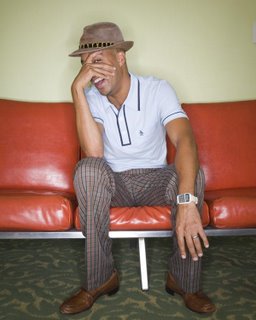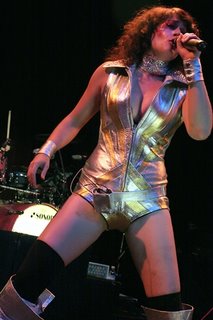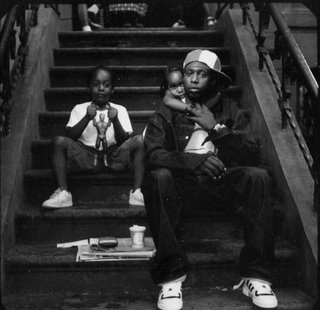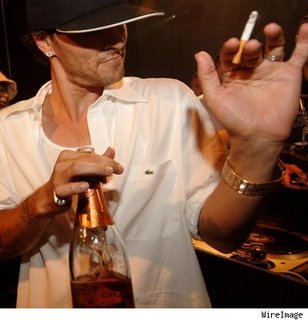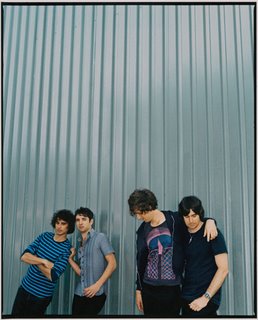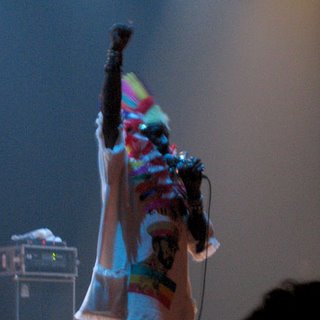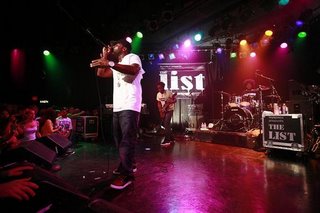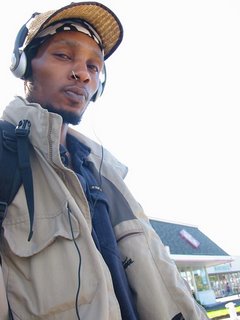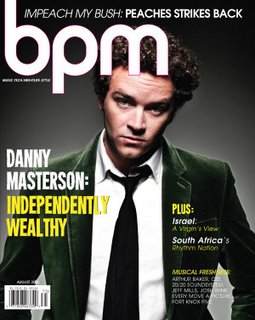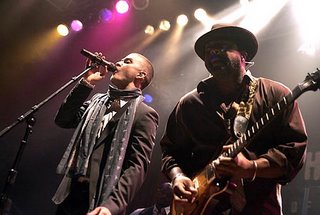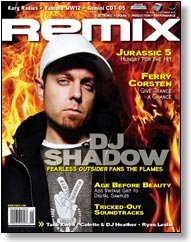
What are the makings of a legend? Throughout the history of contemporary recorded music, precious few bands and artists have faced the seemingly insurmountable task of following up a certified masterpiece — a musical milestone that comes to define its time and is beloved by legions of fans as the soundtrack to a particularly golden moment in life. For DJ Shadow, that moment came with the release of his debut album, 1996's
Endtroducing… (Mo'Wax). Built entirely on an infinite universe of samples (Guinness World Records casts it as the first LP composed completely from sampled sounds), it was the album that introduced the rest of the world to the vinyl-obsessed world of the bedroom DJ/producer, forever searching for long-lost memories and melodies to recombine into something brand new, vital and ultimately timeless. Its intricate arrangements and decidedly hip-hop approach to making mood-driven, emotional music all but defines a major portion of the 1990s, bridging the gaps between the beat-driven pulses of inner-city streets to the choicest of high-end boutiques. Put it on today, and
Endtroducing… still sounds shockingly relevant, as if countless producers and artists haven't spent the last decade desperately trying to replicate its magic.
By the time DJ Shadow himself reemerged with the always-precarious second album, 2002's
The Private Press (MCA), the landscape had more than changed; it had exploded into a million tiny subgenres that found everything from trashy indie rock to glossy hip-hop, spinning new sonic landscapes for a far shrewder and infinitely more astute audience. When
The Private Press played more like a postmodern mixtape than
Endtroducing… part two, fans and critics wondered what happened to their instrumental hip-hop golden child. And don't think he didn't notice, especially when it came time to create his wildly eclectic and exceedingly confident third album,
The Outsider (Universal Motown, 2006).
“With this new album,” Shadow says from his Bay Area home base during a break from tour rehearsals, “it was a case of me sitting down in my studio and going, ‘Okay, what do I like?’ and ‘What do I want to say right now?’ After
The Private Press, I felt like I didn't really have a whole lot more to say in that vein right now. And when I say ‘that vein,’ I mean the sound that most people associate with me, which is a cinematic, kind of emotional and instrumental-type vibe.
“I was a little bit disappointed with how
The Private Press performed,” he admits. “When you're in a business, you don't want to go down, down, down; you want to go up, up, up. I didn't feel very encouraged to head down that direction again, particularly after how that record was received. I also think that in the spirit of being realistic, for me to put out an instrumental record, be it now or 50 years from now, people will always have a knee-jerk reaction and automatically compare it to
Entroducing…. I just didn't feel like dealing with that either,” he adds wearily.
If there was a pigeonhole mold left for DJ Shadow (aka Josh Davis) to shatter, he blows it to bits with the party-time “hyphy” hip-hop meets introspective, Radiohead-ish contemplation that marks the aptly titled new album. “When I was working on that album, I didn't have anybody to try to please, any fan base to satiate,” Shadow says. “I was just making the record I wanted to hear at that time. When I sit down on the rare occasion that I have the time to make a compilation CD of things that are around me, it sounds a lot like
The Outsider. The sound of different types of music smashed right up against each other doesn't bother me. I think in this current iTunes, mixtape world, people are ready for this type of record.”
When you were first coming up as a producer, did you hear any important advice from your mentors about making music?Dan The Automator was pretty important. When I first started working with him back in 1992, he was just a local hip-hop producer, and I devoured any record that he would put out. I don't think he had ever met anybody as gung-ho about talking to him about his own work before me. He's about six or seven years older than me and was definitely something of a mentor. He gave me a lot of advice. I can't say enough about the things he helped me with along the way, especially during the process of making
Endtroducing…. There would be times when I would just need a pep talk, and he was really good for stuff like that. I remember one particular day, when I had one of those awful challenges in the studio and was just wasting time, and I was getting despondent about a track. He got me out of the studio, and we talked about it over dinner. When we got back, I was able to nail the track with his guidance. Just for that alone, I'll always feel kind of indebted to him.
When you start creating a beat, finding a sample or writing a part, how and when do you know which direction it's going to go?Lots of times I sit down intending to do one thing, and by the end of the night, I quickly realize that it's heading in another direction. If that's a direction that I haven't gone in before, then it's exciting for me. If, for whatever reason — whether it's the mood I'm in or just a sequence of decisions that I make — I end up with a weaker version of what I set out to do, then I just let it go.
The Outsider is so diverse, from venturing into the Bay Area — based hyphy scene to more cinematic, funky, rocky or folky sounds. When do you decide if you're going to want a thuggish kind of rap, an ethereal vocal or whatever?Every time I put out a record, I try not to repeat myself. I think that's one of the reasons I found it more fun and rewarding artistically to make tracks that don't sound like what I'm normally associated with. This is my 15th year making records. Most artists that I respect and have a long-term career don't just sit in one place. They evolve. With a song like “3 Freaks,” I set out to make what in hyphy terms is called a “slapper” [characterized by teeth-rattling bass lines]. As unorthodox as it is, I felt really strong about it. It came fairly quickly and hit all of the buttons I wanted to push. But for every track like that, there are three or four that didn't go very far.
Last time Remix talked to you when you were working on The Outsider, you said the album would be a mix of samples and live instruments. How did that play out?I didn't constrict myself to using only vinyl. I was buying vinyl before I made music, and I'll be buying vinyl long after this quote-unquote “crate-digging scene.” Vinyl will always be a tool, but it's nice to sit down and write music, too.
Still, there has to be something — be it a synthesizer sound or a sample — that I feel is worthy of building upon; that's where I start with most tracks. On a song like “Erase You” [featuring singer Chris James], I just wanted to tweak the beat, which is fairly well known in the funk world, into something new. With that beat in particular, I had the intention of it being the beat centerpiece of the album, the one where my programming really comes out. Then I sat down with a keyboard and worked out the melody lines.
With the song “What Have I Done” [with singer Christina Carter], which is one of my favorites on this record, there's not a single live instrument on there, even though to me it sounds like it. I played a lot of Mellotron, and there's a lot of complicated sample work going on. Another one without any live instrumentation would be “Backstage Girl” [featuring rapper Phonte Coleman]. But then there are songs that are all live. Using musicians was just another medium that I wanted to explore. “You Made It” [with Chris James] would be a good example of a song that combines the best of both worlds, live and sampled.
In addition to mixing live parts and samples, you've gotten more into working with MIDI. How did that help your process?After
The Private Press tour, the first thing I did when I came back was to move my studio out of my house into a separate space in the city, so that I was commuting to and from work every day. I told myself that I didn't want to make music on the MPC anymore. It took me a good year of making noise on Pro Tools 7 that didn't sound very good before work on the record started. [Shadow and engineer Count ended up sticking with version 6.9.2.] MIDI is one of those things that can seem very simple once you get it. It's nice when it gets to a point where all of these different technologies aren't mysterious or daunting but instead are conduits for the artistic impulses in the moment. But it takes a long time to get to those places.
You use Native Instruments Battery, Kontakt and Reaktor. In what way did using soft synths and samplers change your music?One of the things that I like about Battery is the concept of injecting a live feel by having the trigger points randomized a little bit. For example, I would randomize the volume and attack of the hi-hats within a certain small parameter. Subconsciously, it begins to feel less robotic. I think that works on songs where you want the drums to sound live.
It also took me a little while to figure out how to place a sample on the computer screen grid to correspond to my MPC. In other words, when I hit the keypad in the lower left corner on the MPC, I wanted the sample in the lower left corner on the screen to play. It might sound simple, but it took days to figure out. Native Instruments stuff isn't always the user-friendliest gear in the world, although I recently heard they just came out with a new tactile device [Kore] that tames all of the different plug-ins into a universal tool. That sounds good to me, since I found that with every different Native Instruments plug-in, the rules were totally different. I'd hit one shortcut key on the keyboard, and it would do one thing with one plug-in and something totally different with another. That's the kind of stuff that I think is daunting to people. I remember talking to producer Droop-E, who did a remix of “3 Freaks,” about Battery, and he said he had to send it back because it was too complicated. I totally sympathize. But that's why I gave myself a good year to wrap my head around all of this technology I was using before I started getting serious about
The Outsider.
Did you have any challenges constructing the more sample-centric tracks on the album?With the song “The Tiger,” just getting that polyrhythmic effect with all of the different percussive samples that are in there was just grueling. It took two weeks to get all of those sounds to work together. Throughout the album, there's a lot of weird time-signature stuff going on. I found “The Tiger” to be rhythmically really exciting, and I didn't want to let that down. “Backstage Girl” was another real hard one, as I set out for it to be the sample showcase on the record. That's for the people who enjoy my ability to combine different samples into one coherent idea, so they could know that I've still got it. [Laughs.] There were just so many tracks on that one. If you listen closely, you can hear that the song speeds up gradually, but I'm still using the same samples. When you're working on a grid, doing that can be a real trick.
When you're working with guest singers or rappers, how do you help bring the best out of them?An example of someone that was totally malleable and willing to go in whatever direction would be Phonte Coleman [of the hip-hop trio Little Brother] on the song “Backstage Girl.” He flew here from North Carolina right in the middle of a lot of family stuff. He came in, put his head down and went to work. No matter what I threw at him, he was ready to give it a try. It was a truly easy and effortless experience. Everything that he did, he kind of nailed on the first try. That's an example of a dream experience. Then you have people who take a little bit of direction, and then what they end up doing may or may not be anything like you had in mind. I think one of the challenges for me when that happens is figuring out how to make the track my own again. That's why when I give people tracks to write to, I only finish them halfway. I know there's no point in finishing it before they've added their part. I like to see what people bring to the table, so I can wrap the track around what they wrote.
When a song just isn't working for you, how do you tackle trying to get it back on track?That's the great struggle. When I finish a day of work, and I feel really shitty about it, that's when I just strip everything back and basically start over. The older I get, it just feels like I have a lot less time to do what I have to do than I used to. I find myself having to deal with a lot more shit I'd rather not deal with than I did when I was 21 and in college. You just don't care at that age, and you're willing to work for 12 hours straight. I find that really hard to do now.
[Nowadays], there seems to be pressure to get more stuff done when you have that time set aside specifically to work. I hate those days. The song “Enuff” [featuring Lateef the Truth Speaker and Q-Tip], was one that at a certain point I was really struggling with. I'd gotten the music quite far along compared to a lot of demos that I do, but it still wasn't coming together. It's like looking at a Rubik's Cube and thinking you'll never fucking figure the damn thing out. But then you make that one twist, and suddenly it starts to make sense. A few twists later, and there you have it. Although I never did figure out how to solve a Rubik's Cube, so perhaps that's not the best analogy. When those things happen and you make all the right decisions, it feels really good and is the most rewarding. I think that's the reason why I'm uncharacteristically vocal about how much I love this album.
The Outsider has the highest ratio of successes to failures as far as seeing songs through to the end in the way that I originally envisioned them.
Do you have a song junkyard that you visit to resurrect certain songs parts from?The song “Six Days” from
The Private Press is the best example of that. Back in 1994, I'd intended to do an EP with the [rapper] Gift of Gab, and even though the music at the time was some of my best work, for whatever reason, we couldn't get it together. So those tracks were just always languishing in the archives. By the time I was working on
The Private Press, I ended up going back to the original record where I'd mined the main loop of one of those old songs and totally rethinking the way I used and treated it. The more I listened to it, the more I realized that I needed to finish the track. “Six Days” will always be one of my personal favorites. That song, along with “You Can't Go Home Again,” really hit the spot as far as what I was trying to do with that album.
At what point do you abandon a grandiose idea or sample combination to save the song?Even when I spend two weeks on something, I feel like I have a pretty good internal monitor to let me know if I'm doing something good or just wasting time. At the time I was working on “The Tiger,” I felt like it was worth investing the time. It provided a really unique element to the album that I just didn't want to fuck up. I recently saw the movie
Dig! There are a lot of scenes where Antone Newcombe, the main guy from the Brian Jonestown Massacre, seems to be just spinning his wheels in the studio. I've seen that throughout my whole career and even felt it at various times. I think that the biggest mistake any artist can do is to not release their effort at some point. I've seen so many friends of mine do great albums and then spend the next three months just second-guessing the whole project and not putting it out. That's just a real shame, I think. For me, when the time you've given yourself to record is up, just put it out, good or bad.
That's why I think I'm so hard on myself in the studio because I don't want to confront failure. Although I have had to deal with it, like on the UNKLE album [the 1998
Psyence Fiction record Shadow made with Mo'Wax founder James Lavelle, which corralled guest vocalists such as Radiohead's Thom Yorke, The Verve's Richard Ashcroft and Beastie Boy Mike D]. When we were mastering it, I knew in my heart that it was missing a song or two. I was really conflicted about the nominal segues between the songs because I thought they were just a waste and not helping the album. But you never know that until you get to sequencing. That's the day of reckoning. With
Endtroducing…, sequencing was really effortless. With the UNKLE record, I think there are great songs there, some among my best work. But as an album, it doesn't really hold together. With
The Outsider, I felt good during sequencing. I wasn't intimidated by the different nature of the various songs, and it came together in the end as a complete album.
(Originally published as the cover story of REMIX Magazine, Sept. 06)






